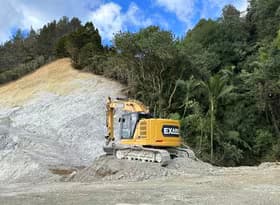Residential construction’s backlog and looming downturn
In recent months, one of the common questions when talking to firms involved in residential construction is about the timing and steepness of the looming downturn in activity for the industry. Data released earlier this week showed that total consent numbers in the three months to May were down 23% from a year ago. The annual consent total has now retreated to 45,159, down from 51,015 at its peak in May last year.
But with many industry observers believing an actual build rate of anything over 40,000pa is unreachable, does that mean the current rate of consenting is still adding to the backlog of work waiting to get done?
An update on the trend in completions
Auckland Council is the only area that regularly publishes data on code compliance certificates (CCCs), and so provides us with some insights into how completions are likely to be trending. The latest data from Auckland Council shows the gap between dwelling consents issued two years ago and current CCCs is at its largest on record (stretching back to 2013). In the year to April 2021, there were 18,223 new dwelling consents issued in the city, but just 14,691 homes were issued CCCs in the year to April 2023 (see Chart 1). The “completion” rate of 81% is well below the pre-COVID low of 86% recorded in the year to May 2019.
Interestingly, additional data from Auckland Council shows that the proportion of CCCs being issued for new dwellings within two years of the building consent being issued has been reasonably steady since late 2020, holding between 77% and 84% of all CCCs. Given that supply chain issues and capacity constraints have been such a dominant theme in the construction industry during 2021 and 2022, we would have expected an increasing proportion of new dwellings to be delayed and take longer than two years to be completed. Importantly, however, the data in Chart 2 does not take account of CCCs that have not been issued, so if there has been a recent increase in the number of dwellings taking more than two years to get a CCC, it will be yet to show up in the data.
As Chart 1 shows, CCC numbers in Auckland will have to rise another 50% by September next year if they’re going to match the peak in consents reached in the second half of 2022. Given capacity constraints within the construction industry, growth of this magnitude seems unlikely to occur, and we expect CCC numbers to max out at a level below consents. There’s also an increasing probability that previously consented projects are postponed or cancelled because of falling house prices and significantly higher construction costs.1
Nevertheless, there are also some reasons to be hopeful that CCC numbers will continue to improve from here. Just like the lockdown in 2020 caused a temporary decline in CCC issuance, the extended lockdown in the upper North Island in the second half of 2021 will also be negatively affecting CCC numbers now. Furthermore, the Omicron outbreak in the first half of 2022 will have hit activity, and materials shortages during 2022, most notably for plasterboard, will also have extended the timeframes for work get done. It could be mid-late 2024 before the effects of these delaying factors have fallen out of the numbers.
A dynamic look at Hamilton’s pipeline of work
Additional data provided to us by Hamilton City Council2 provides an insight into the expansion of the residential construction pipeline as consent numbers in the city have increased throughout the last decade. Chart 3 compares the number of dwelling consents in Hamilton over the last five years that have not been granted a CCC (in other words, have not been completed) with the number of consented dwellings over the last five years that have not been granted a CCC but have had at least one building inspection done (in other words, started but not completed). The gap between the two lines effectively represents the pipeline or backlog of consents that have been granted, but where building work has yet to get underway.
Chart 4 and Chart 5 show the corresponding data split into standalone houses and attached dwellings. Most of the very strong growth in overall consent numbers, particularly since 2018, has been driven by attached dwellings. As a result, Chart 4 shows that the size of the pipeline of new standalone houses waiting to begin construction is a similar size to what it was a decade ago. In contrast, the pipeline of attached dwellings awaiting construction in Chart 5 has expanded significantly.
Although the pipeline of attached dwellings looks a lot bigger in the previous charts, Chart 6 provides a different perspective on the numbers. It shows that the proportion of uncompleted dwellings that have not started construction has been reasonably similar across both attached dwellings and standalone houses throughout the last decade. Furthermore, at 37%, the current proportion of un-started dwellings is similar to the corresponding figure at the start of 2013 (35%).
However, the early 2013 figures should be treated with some caution, because the five-year window will include dwellings consented in 2008. Dwellings consented throughout 2008 will have been less likely to be built when the Global Financial Crisis blew up later that year and lending conditions tightened substantially. In our view, the average proportion of un-started dwellings between 2014 and 2017, at 22%, provides a much better indication of the industry when capacity constraints are not a limiting factor.
Comparing consents with work put in place
Nationwide consent and work put in place data hints at the possible backlog of work as well as the looming downturn in activity that is around the corner. Although work put in place normally matches consents closely, activity in the year to March 2022 failed to increase in line with new dwelling consents and remained 11% lower. If we look at the gap over the last nine months, some of this backlog might have been caught up. However, the failure of work put in place to fall away in the last few quarters, as consents have done, could also simply represent the normal lag between consents being issued and work being done.
Even if the backlog of activity in 2021/22 is still to be worked through, and work put in place holds up for another 6-9 months, the decline in consent volumes is still instructive of where residential construction is headed. Our April forecasts predicted an 11%pa decline in the annual total of new residential work put in place by the end of this year, and we will be publishing updated Building Forecasts for our clients on Thursday 13 July.
1 We examined completion rates, based on data from Stats NZ, in Chart 6 of our June 2022 analysis: New data highlights increased timeframes for construction projects.
2 Thanks to Andy Zhao and Tiki Mossop at Hamilton City Council for provision of this data and permission to use it.













